A Comprehensive Study of Load Balancing in Cloud Computing
VerifiedAdded on 2023/02/01
|45
|10860
|52
Project
AI Summary
This project delves into the critical domain of load balancing within cloud computing environments, a process that dynamically shifts workloads to optimize resource utilization and enhance system performance. The research focuses on developing and analyzing load balancing algorithms for virtual machines in hybrid cloud settings. The study explores the significance of load balancing in ensuring even distribution of resources, improving throughput, and increasing scalability. It investigates both static and dynamic load balancing techniques, addressing the challenges and issues that arise in cloud environments. The project also presents a detailed examination of the research methodology, including the design of a proposed load balancing algorithm, experimental results, and conclusions about its effectiveness. The findings highlight the importance of effective load balancing strategies to reduce response times, improve resource utilization, and manage the complexities of cloud computing.
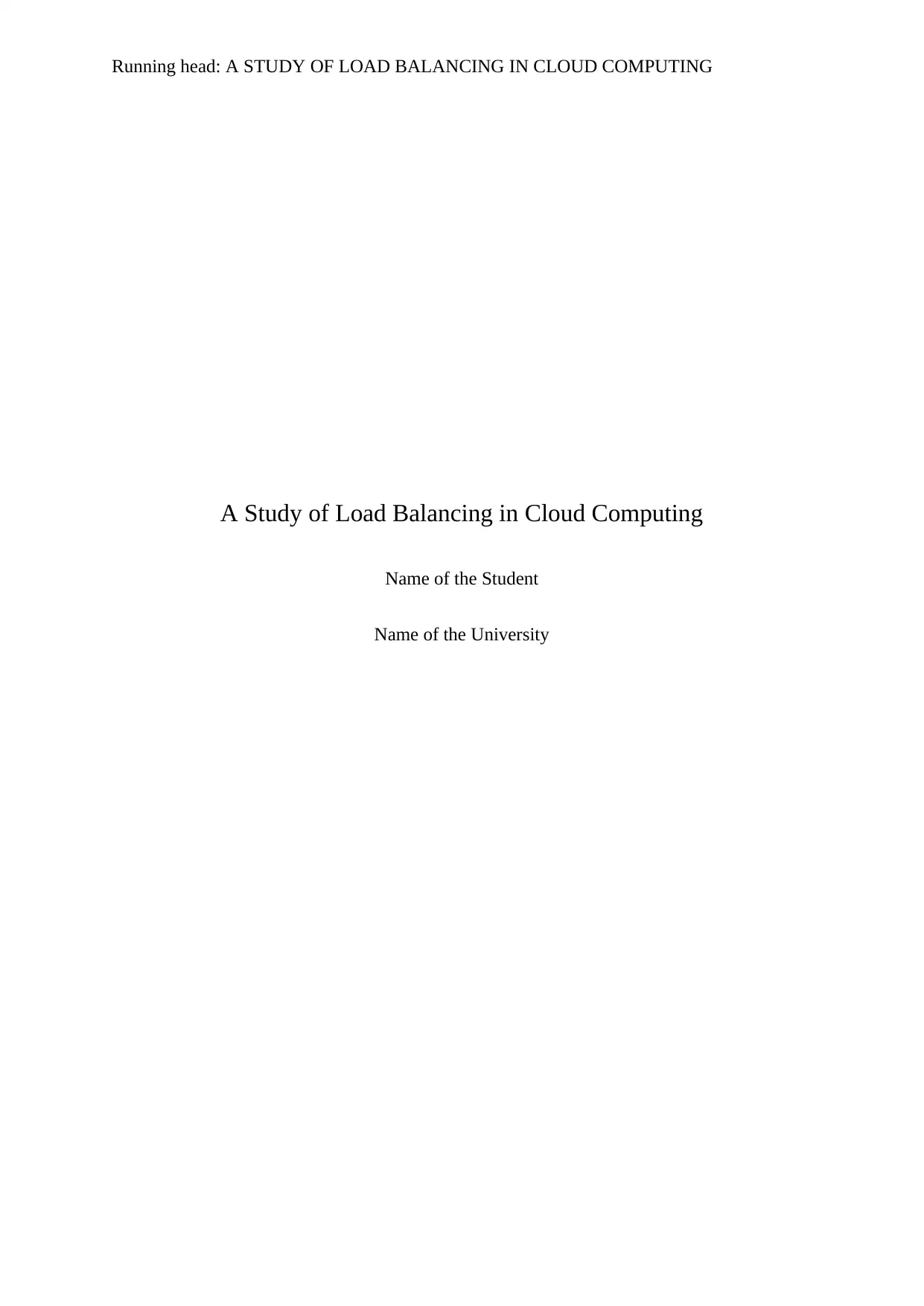
Running head: A STUDY OF LOAD BALANCING IN CLOUD COMPUTING
A Study of Load Balancing in Cloud Computing
Name of the Student
Name of the University
A Study of Load Balancing in Cloud Computing
Name of the Student
Name of the University
Paraphrase This Document
Need a fresh take? Get an instant paraphrase of this document with our AI Paraphraser
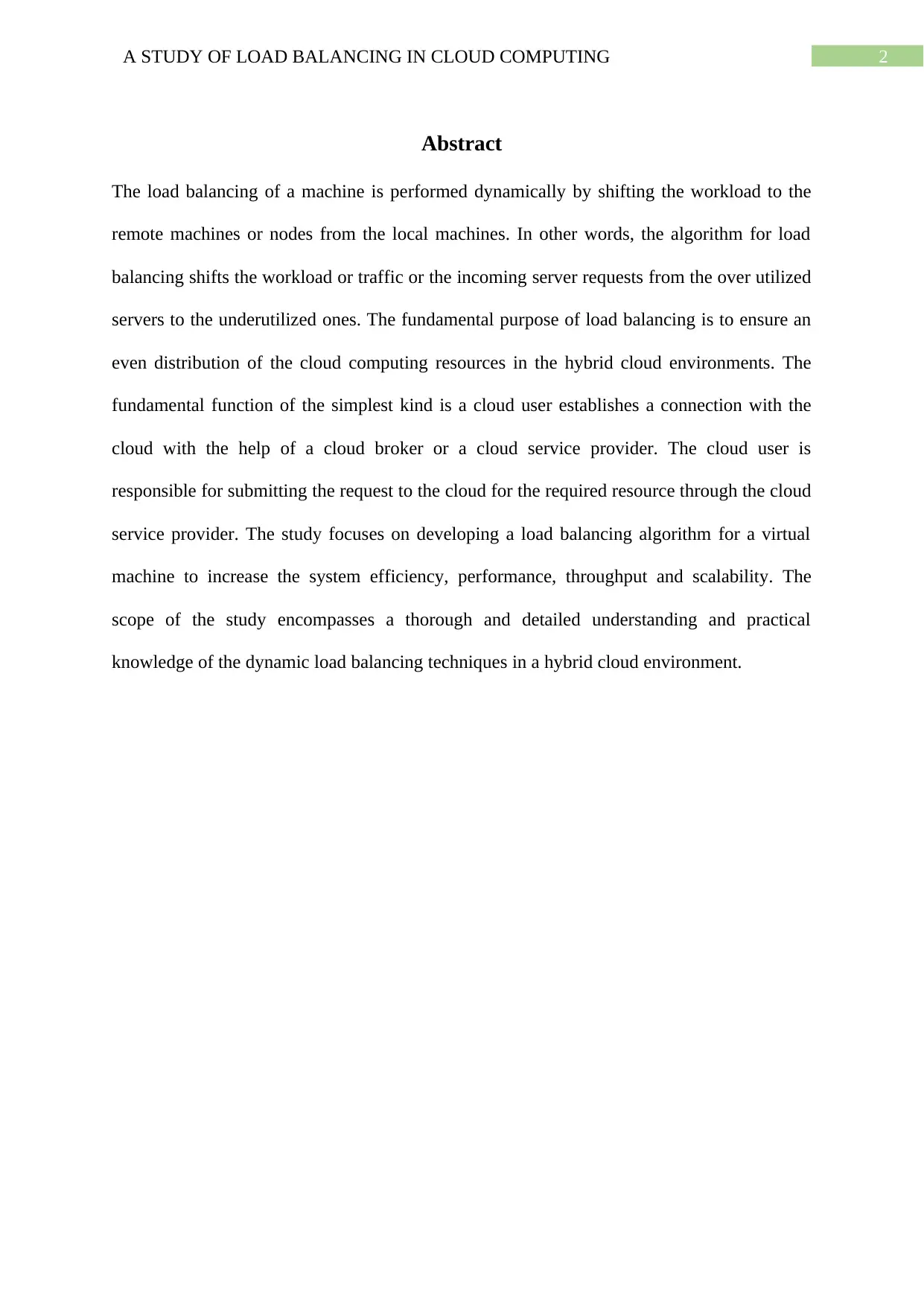
2A STUDY OF LOAD BALANCING IN CLOUD COMPUTING
Abstract
The load balancing of a machine is performed dynamically by shifting the workload to the
remote machines or nodes from the local machines. In other words, the algorithm for load
balancing shifts the workload or traffic or the incoming server requests from the over utilized
servers to the underutilized ones. The fundamental purpose of load balancing is to ensure an
even distribution of the cloud computing resources in the hybrid cloud environments. The
fundamental function of the simplest kind is a cloud user establishes a connection with the
cloud with the help of a cloud broker or a cloud service provider. The cloud user is
responsible for submitting the request to the cloud for the required resource through the cloud
service provider. The study focuses on developing a load balancing algorithm for a virtual
machine to increase the system efficiency, performance, throughput and scalability. The
scope of the study encompasses a thorough and detailed understanding and practical
knowledge of the dynamic load balancing techniques in a hybrid cloud environment.
Abstract
The load balancing of a machine is performed dynamically by shifting the workload to the
remote machines or nodes from the local machines. In other words, the algorithm for load
balancing shifts the workload or traffic or the incoming server requests from the over utilized
servers to the underutilized ones. The fundamental purpose of load balancing is to ensure an
even distribution of the cloud computing resources in the hybrid cloud environments. The
fundamental function of the simplest kind is a cloud user establishes a connection with the
cloud with the help of a cloud broker or a cloud service provider. The cloud user is
responsible for submitting the request to the cloud for the required resource through the cloud
service provider. The study focuses on developing a load balancing algorithm for a virtual
machine to increase the system efficiency, performance, throughput and scalability. The
scope of the study encompasses a thorough and detailed understanding and practical
knowledge of the dynamic load balancing techniques in a hybrid cloud environment.
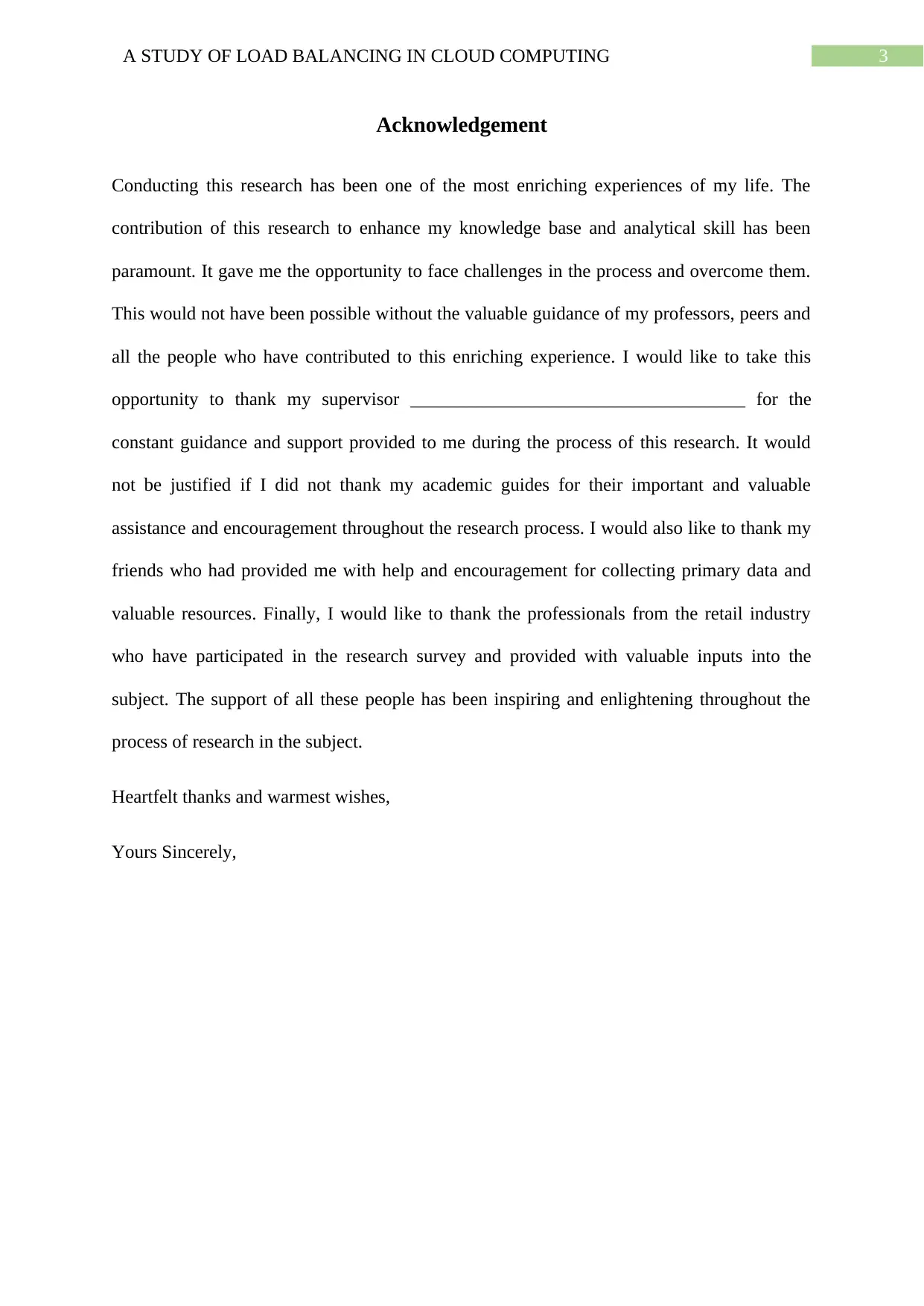
3A STUDY OF LOAD BALANCING IN CLOUD COMPUTING
Acknowledgement
Conducting this research has been one of the most enriching experiences of my life. The
contribution of this research to enhance my knowledge base and analytical skill has been
paramount. It gave me the opportunity to face challenges in the process and overcome them.
This would not have been possible without the valuable guidance of my professors, peers and
all the people who have contributed to this enriching experience. I would like to take this
opportunity to thank my supervisor ____________________________________ for the
constant guidance and support provided to me during the process of this research. It would
not be justified if I did not thank my academic guides for their important and valuable
assistance and encouragement throughout the research process. I would also like to thank my
friends who had provided me with help and encouragement for collecting primary data and
valuable resources. Finally, I would like to thank the professionals from the retail industry
who have participated in the research survey and provided with valuable inputs into the
subject. The support of all these people has been inspiring and enlightening throughout the
process of research in the subject.
Heartfelt thanks and warmest wishes,
Yours Sincerely,
Acknowledgement
Conducting this research has been one of the most enriching experiences of my life. The
contribution of this research to enhance my knowledge base and analytical skill has been
paramount. It gave me the opportunity to face challenges in the process and overcome them.
This would not have been possible without the valuable guidance of my professors, peers and
all the people who have contributed to this enriching experience. I would like to take this
opportunity to thank my supervisor ____________________________________ for the
constant guidance and support provided to me during the process of this research. It would
not be justified if I did not thank my academic guides for their important and valuable
assistance and encouragement throughout the research process. I would also like to thank my
friends who had provided me with help and encouragement for collecting primary data and
valuable resources. Finally, I would like to thank the professionals from the retail industry
who have participated in the research survey and provided with valuable inputs into the
subject. The support of all these people has been inspiring and enlightening throughout the
process of research in the subject.
Heartfelt thanks and warmest wishes,
Yours Sincerely,
⊘ This is a preview!⊘
Do you want full access?
Subscribe today to unlock all pages.

Trusted by 1+ million students worldwide
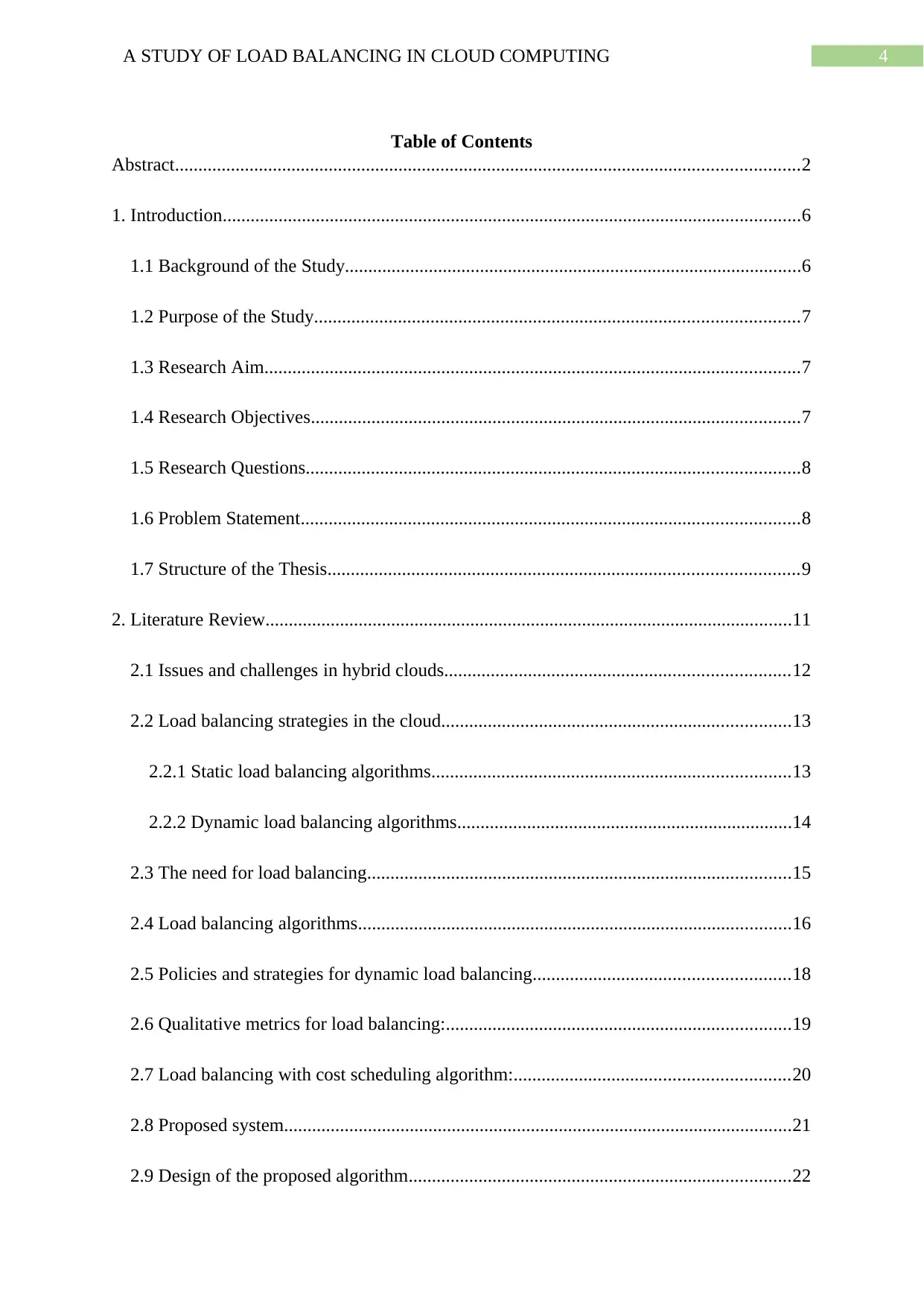
4A STUDY OF LOAD BALANCING IN CLOUD COMPUTING
Table of Contents
Abstract......................................................................................................................................2
1. Introduction............................................................................................................................6
1.1 Background of the Study..................................................................................................6
1.2 Purpose of the Study........................................................................................................7
1.3 Research Aim...................................................................................................................7
1.4 Research Objectives.........................................................................................................7
1.5 Research Questions..........................................................................................................8
1.6 Problem Statement...........................................................................................................8
1.7 Structure of the Thesis.....................................................................................................9
2. Literature Review.................................................................................................................11
2.1 Issues and challenges in hybrid clouds..........................................................................12
2.2 Load balancing strategies in the cloud...........................................................................13
2.2.1 Static load balancing algorithms.............................................................................13
2.2.2 Dynamic load balancing algorithms........................................................................14
2.3 The need for load balancing...........................................................................................15
2.4 Load balancing algorithms.............................................................................................16
2.5 Policies and strategies for dynamic load balancing.......................................................18
2.6 Qualitative metrics for load balancing:..........................................................................19
2.7 Load balancing with cost scheduling algorithm:...........................................................20
2.8 Proposed system.............................................................................................................21
2.9 Design of the proposed algorithm..................................................................................22
Table of Contents
Abstract......................................................................................................................................2
1. Introduction............................................................................................................................6
1.1 Background of the Study..................................................................................................6
1.2 Purpose of the Study........................................................................................................7
1.3 Research Aim...................................................................................................................7
1.4 Research Objectives.........................................................................................................7
1.5 Research Questions..........................................................................................................8
1.6 Problem Statement...........................................................................................................8
1.7 Structure of the Thesis.....................................................................................................9
2. Literature Review.................................................................................................................11
2.1 Issues and challenges in hybrid clouds..........................................................................12
2.2 Load balancing strategies in the cloud...........................................................................13
2.2.1 Static load balancing algorithms.............................................................................13
2.2.2 Dynamic load balancing algorithms........................................................................14
2.3 The need for load balancing...........................................................................................15
2.4 Load balancing algorithms.............................................................................................16
2.5 Policies and strategies for dynamic load balancing.......................................................18
2.6 Qualitative metrics for load balancing:..........................................................................19
2.7 Load balancing with cost scheduling algorithm:...........................................................20
2.8 Proposed system.............................................................................................................21
2.9 Design of the proposed algorithm..................................................................................22
Paraphrase This Document
Need a fresh take? Get an instant paraphrase of this document with our AI Paraphraser
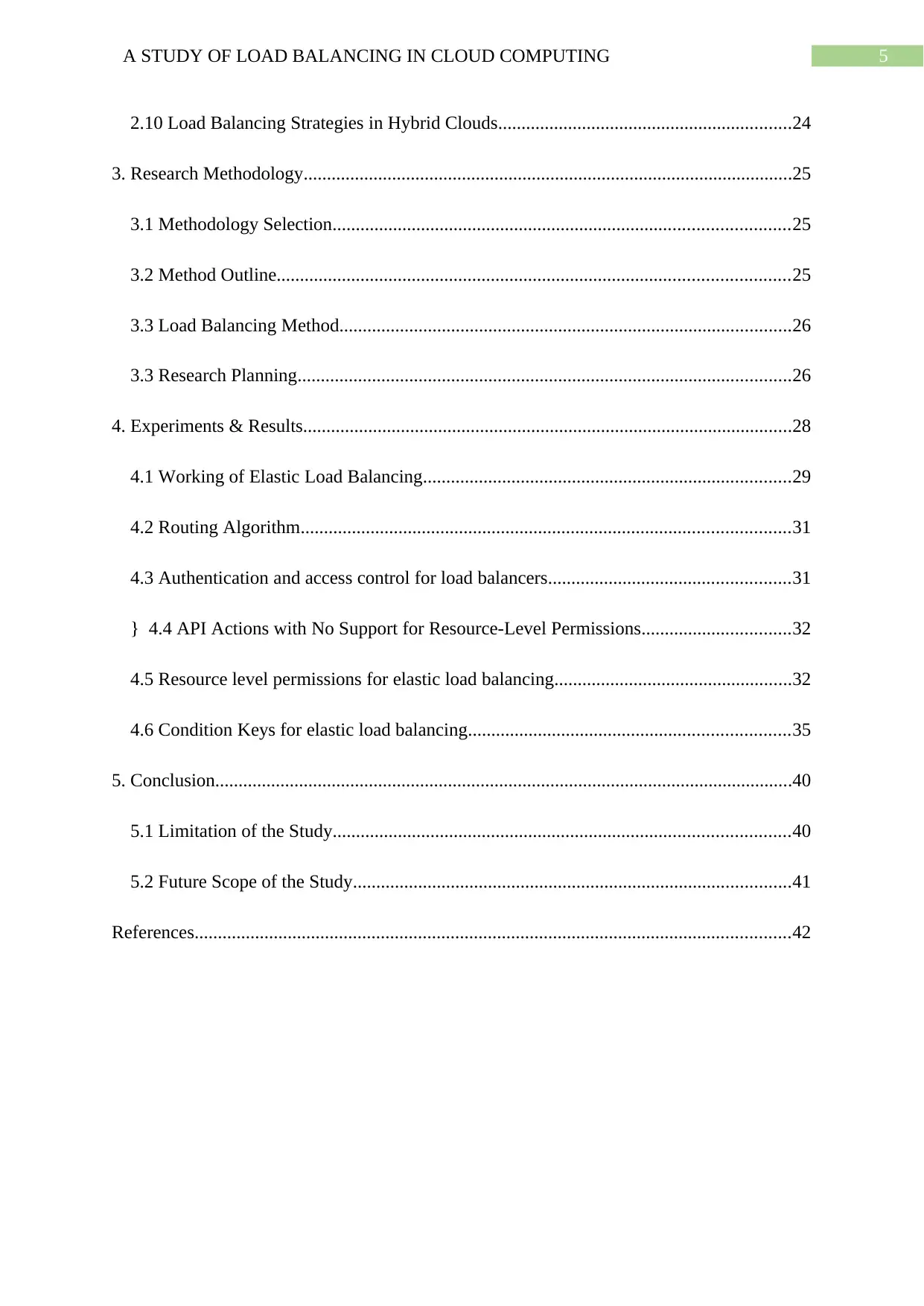
5A STUDY OF LOAD BALANCING IN CLOUD COMPUTING
2.10 Load Balancing Strategies in Hybrid Clouds...............................................................24
3. Research Methodology.........................................................................................................25
3.1 Methodology Selection..................................................................................................25
3.2 Method Outline..............................................................................................................25
3.3 Load Balancing Method.................................................................................................26
3.3 Research Planning..........................................................................................................26
4. Experiments & Results.........................................................................................................28
4.1 Working of Elastic Load Balancing...............................................................................29
4.2 Routing Algorithm.........................................................................................................31
4.3 Authentication and access control for load balancers....................................................31
} 4.4 API Actions with No Support for Resource-Level Permissions................................32
4.5 Resource level permissions for elastic load balancing...................................................32
4.6 Condition Keys for elastic load balancing.....................................................................35
5. Conclusion............................................................................................................................40
5.1 Limitation of the Study..................................................................................................40
5.2 Future Scope of the Study..............................................................................................41
References................................................................................................................................42
2.10 Load Balancing Strategies in Hybrid Clouds...............................................................24
3. Research Methodology.........................................................................................................25
3.1 Methodology Selection..................................................................................................25
3.2 Method Outline..............................................................................................................25
3.3 Load Balancing Method.................................................................................................26
3.3 Research Planning..........................................................................................................26
4. Experiments & Results.........................................................................................................28
4.1 Working of Elastic Load Balancing...............................................................................29
4.2 Routing Algorithm.........................................................................................................31
4.3 Authentication and access control for load balancers....................................................31
} 4.4 API Actions with No Support for Resource-Level Permissions................................32
4.5 Resource level permissions for elastic load balancing...................................................32
4.6 Condition Keys for elastic load balancing.....................................................................35
5. Conclusion............................................................................................................................40
5.1 Limitation of the Study..................................................................................................40
5.2 Future Scope of the Study..............................................................................................41
References................................................................................................................................42
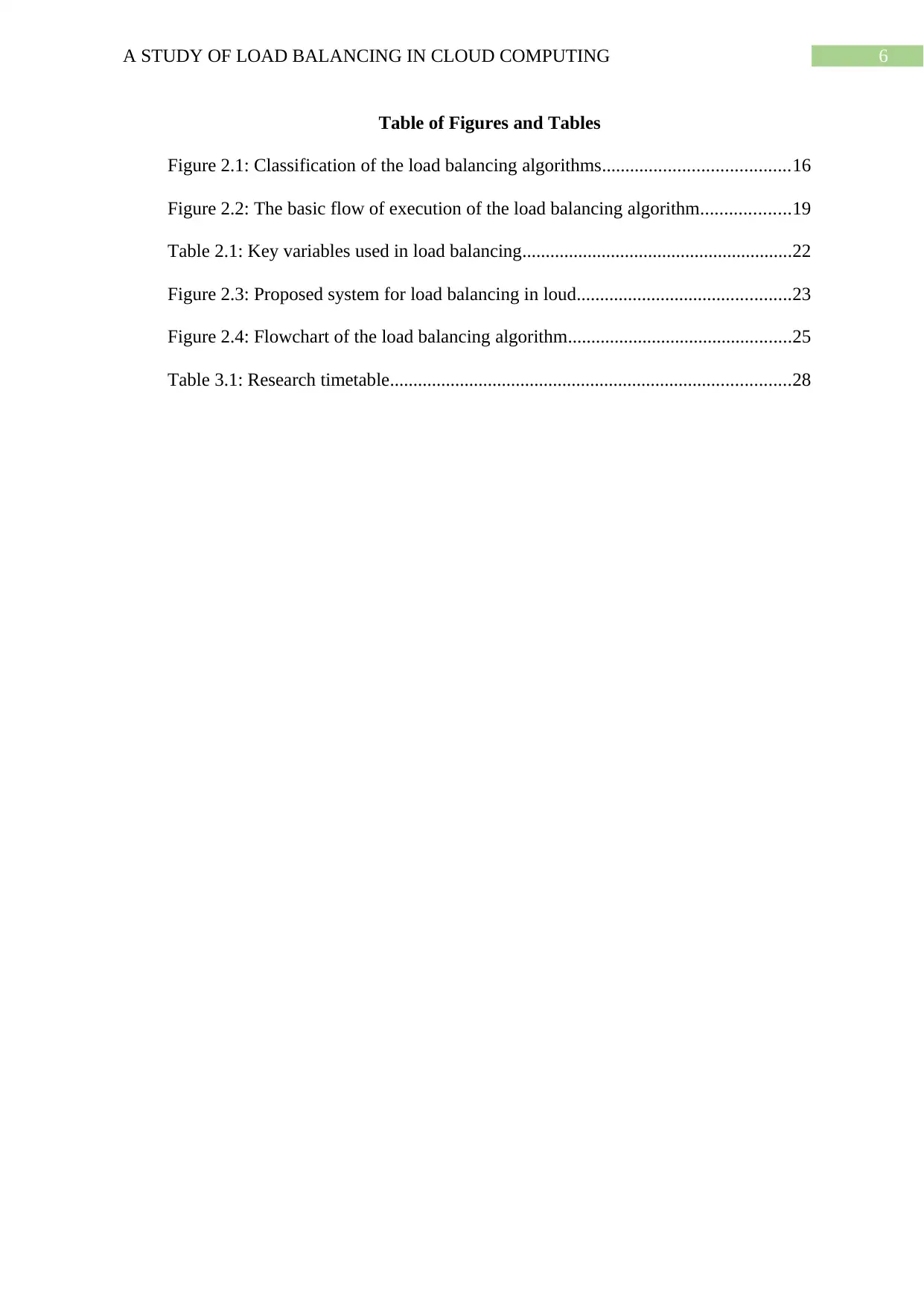
6A STUDY OF LOAD BALANCING IN CLOUD COMPUTING
Table of Figures and Tables
Figure 2.1: Classification of the load balancing algorithms........................................16
Figure 2.2: The basic flow of execution of the load balancing algorithm...................19
Table 2.1: Key variables used in load balancing..........................................................22
Figure 2.3: Proposed system for load balancing in loud..............................................23
Figure 2.4: Flowchart of the load balancing algorithm................................................25
Table 3.1: Research timetable......................................................................................28
Table of Figures and Tables
Figure 2.1: Classification of the load balancing algorithms........................................16
Figure 2.2: The basic flow of execution of the load balancing algorithm...................19
Table 2.1: Key variables used in load balancing..........................................................22
Figure 2.3: Proposed system for load balancing in loud..............................................23
Figure 2.4: Flowchart of the load balancing algorithm................................................25
Table 3.1: Research timetable......................................................................................28
⊘ This is a preview!⊘
Do you want full access?
Subscribe today to unlock all pages.

Trusted by 1+ million students worldwide
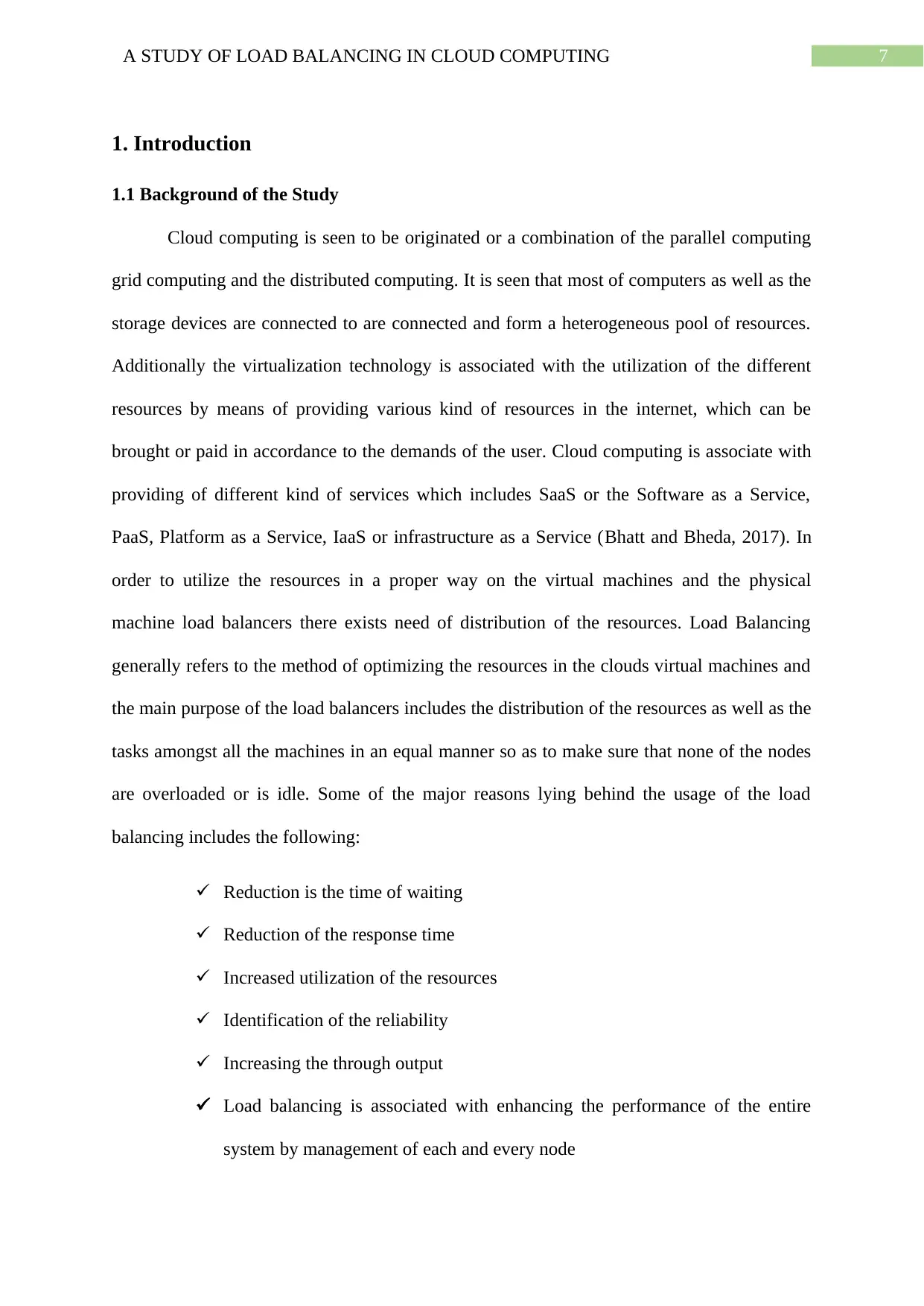
7A STUDY OF LOAD BALANCING IN CLOUD COMPUTING
1. Introduction
1.1 Background of the Study
Cloud computing is seen to be originated or a combination of the parallel computing
grid computing and the distributed computing. It is seen that most of computers as well as the
storage devices are connected to are connected and form a heterogeneous pool of resources.
Additionally the virtualization technology is associated with the utilization of the different
resources by means of providing various kind of resources in the internet, which can be
brought or paid in accordance to the demands of the user. Cloud computing is associate with
providing of different kind of services which includes SaaS or the Software as a Service,
PaaS, Platform as a Service, IaaS or infrastructure as a Service (Bhatt and Bheda, 2017). In
order to utilize the resources in a proper way on the virtual machines and the physical
machine load balancers there exists need of distribution of the resources. Load Balancing
generally refers to the method of optimizing the resources in the clouds virtual machines and
the main purpose of the load balancers includes the distribution of the resources as well as the
tasks amongst all the machines in an equal manner so as to make sure that none of the nodes
are overloaded or is idle. Some of the major reasons lying behind the usage of the load
balancing includes the following:
Reduction is the time of waiting
Reduction of the response time
Increased utilization of the resources
Identification of the reliability
Increasing the through output
Load balancing is associated with enhancing the performance of the entire
system by management of each and every node
1. Introduction
1.1 Background of the Study
Cloud computing is seen to be originated or a combination of the parallel computing
grid computing and the distributed computing. It is seen that most of computers as well as the
storage devices are connected to are connected and form a heterogeneous pool of resources.
Additionally the virtualization technology is associated with the utilization of the different
resources by means of providing various kind of resources in the internet, which can be
brought or paid in accordance to the demands of the user. Cloud computing is associate with
providing of different kind of services which includes SaaS or the Software as a Service,
PaaS, Platform as a Service, IaaS or infrastructure as a Service (Bhatt and Bheda, 2017). In
order to utilize the resources in a proper way on the virtual machines and the physical
machine load balancers there exists need of distribution of the resources. Load Balancing
generally refers to the method of optimizing the resources in the clouds virtual machines and
the main purpose of the load balancers includes the distribution of the resources as well as the
tasks amongst all the machines in an equal manner so as to make sure that none of the nodes
are overloaded or is idle. Some of the major reasons lying behind the usage of the load
balancing includes the following:
Reduction is the time of waiting
Reduction of the response time
Increased utilization of the resources
Identification of the reliability
Increasing the through output
Load balancing is associated with enhancing the performance of the entire
system by management of each and every node
Paraphrase This Document
Need a fresh take? Get an instant paraphrase of this document with our AI Paraphraser
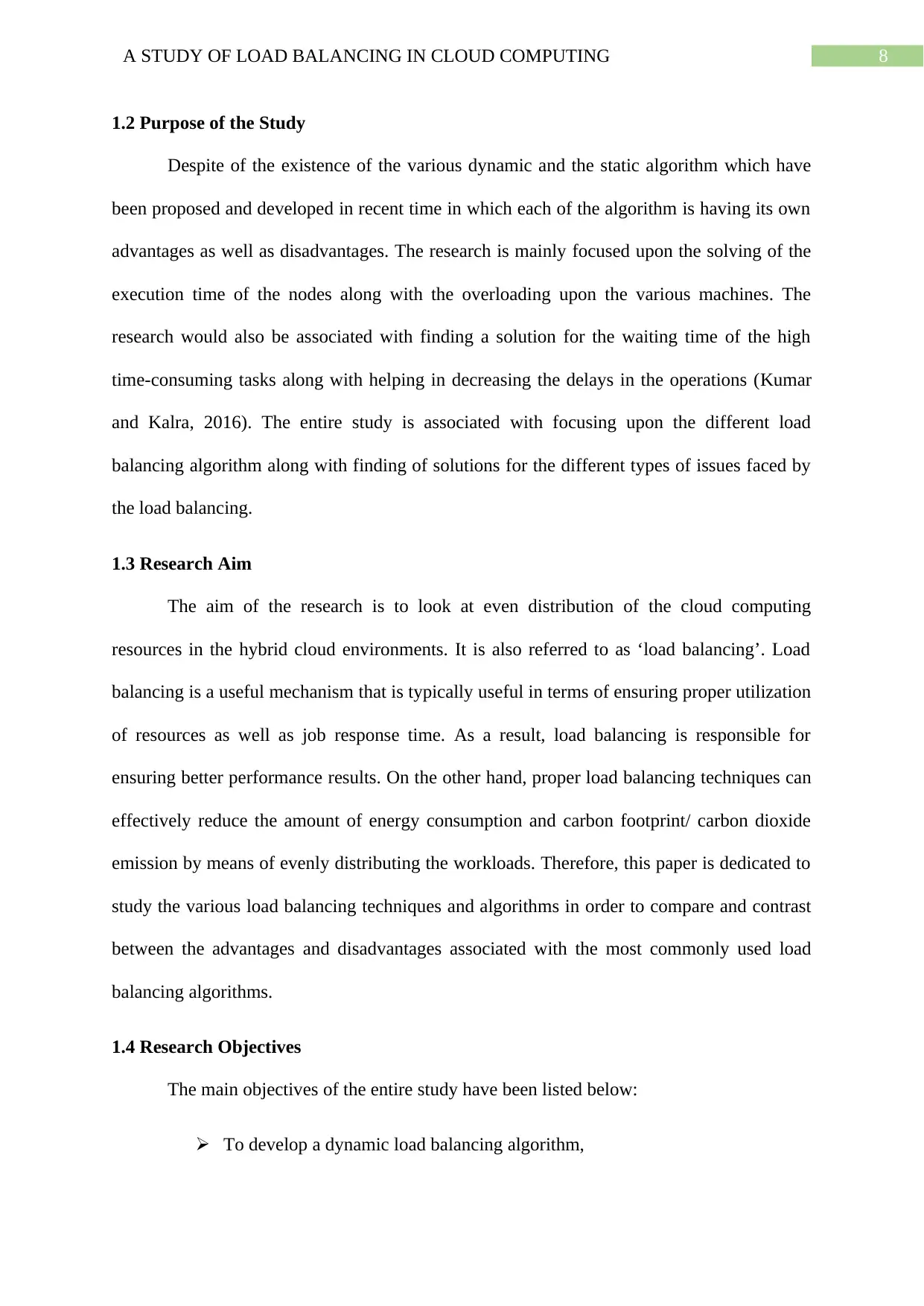
8A STUDY OF LOAD BALANCING IN CLOUD COMPUTING
1.2 Purpose of the Study
Despite of the existence of the various dynamic and the static algorithm which have
been proposed and developed in recent time in which each of the algorithm is having its own
advantages as well as disadvantages. The research is mainly focused upon the solving of the
execution time of the nodes along with the overloading upon the various machines. The
research would also be associated with finding a solution for the waiting time of the high
time-consuming tasks along with helping in decreasing the delays in the operations (Kumar
and Kalra, 2016). The entire study is associated with focusing upon the different load
balancing algorithm along with finding of solutions for the different types of issues faced by
the load balancing.
1.3 Research Aim
The aim of the research is to look at even distribution of the cloud computing
resources in the hybrid cloud environments. It is also referred to as ‘load balancing’. Load
balancing is a useful mechanism that is typically useful in terms of ensuring proper utilization
of resources as well as job response time. As a result, load balancing is responsible for
ensuring better performance results. On the other hand, proper load balancing techniques can
effectively reduce the amount of energy consumption and carbon footprint/ carbon dioxide
emission by means of evenly distributing the workloads. Therefore, this paper is dedicated to
study the various load balancing techniques and algorithms in order to compare and contrast
between the advantages and disadvantages associated with the most commonly used load
balancing algorithms.
1.4 Research Objectives
The main objectives of the entire study have been listed below:
To develop a dynamic load balancing algorithm,
1.2 Purpose of the Study
Despite of the existence of the various dynamic and the static algorithm which have
been proposed and developed in recent time in which each of the algorithm is having its own
advantages as well as disadvantages. The research is mainly focused upon the solving of the
execution time of the nodes along with the overloading upon the various machines. The
research would also be associated with finding a solution for the waiting time of the high
time-consuming tasks along with helping in decreasing the delays in the operations (Kumar
and Kalra, 2016). The entire study is associated with focusing upon the different load
balancing algorithm along with finding of solutions for the different types of issues faced by
the load balancing.
1.3 Research Aim
The aim of the research is to look at even distribution of the cloud computing
resources in the hybrid cloud environments. It is also referred to as ‘load balancing’. Load
balancing is a useful mechanism that is typically useful in terms of ensuring proper utilization
of resources as well as job response time. As a result, load balancing is responsible for
ensuring better performance results. On the other hand, proper load balancing techniques can
effectively reduce the amount of energy consumption and carbon footprint/ carbon dioxide
emission by means of evenly distributing the workloads. Therefore, this paper is dedicated to
study the various load balancing techniques and algorithms in order to compare and contrast
between the advantages and disadvantages associated with the most commonly used load
balancing algorithms.
1.4 Research Objectives
The main objectives of the entire study have been listed below:
To develop a dynamic load balancing algorithm,
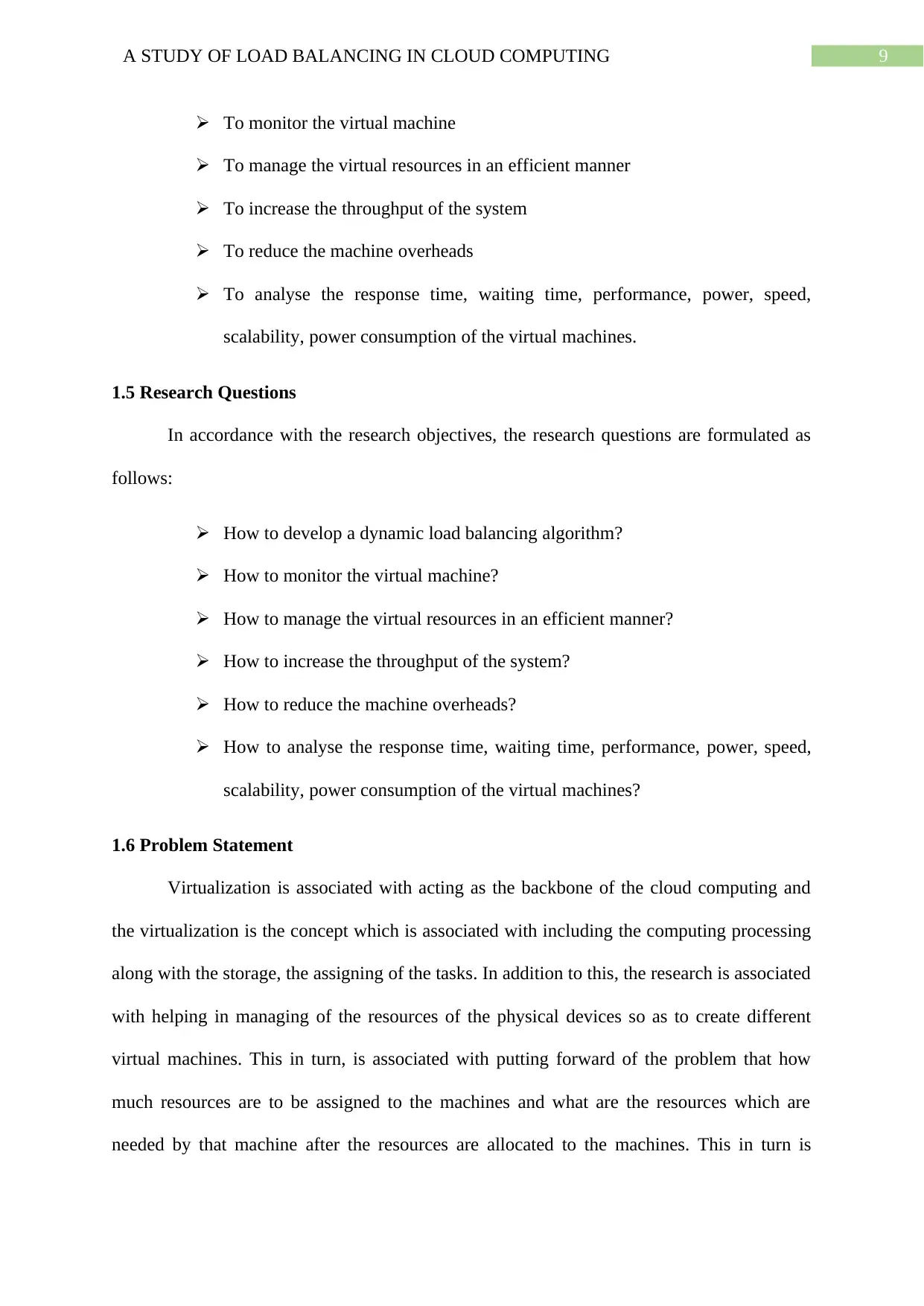
9A STUDY OF LOAD BALANCING IN CLOUD COMPUTING
To monitor the virtual machine
To manage the virtual resources in an efficient manner
To increase the throughput of the system
To reduce the machine overheads
To analyse the response time, waiting time, performance, power, speed,
scalability, power consumption of the virtual machines.
1.5 Research Questions
In accordance with the research objectives, the research questions are formulated as
follows:
How to develop a dynamic load balancing algorithm?
How to monitor the virtual machine?
How to manage the virtual resources in an efficient manner?
How to increase the throughput of the system?
How to reduce the machine overheads?
How to analyse the response time, waiting time, performance, power, speed,
scalability, power consumption of the virtual machines?
1.6 Problem Statement
Virtualization is associated with acting as the backbone of the cloud computing and
the virtualization is the concept which is associated with including the computing processing
along with the storage, the assigning of the tasks. In addition to this, the research is associated
with helping in managing of the resources of the physical devices so as to create different
virtual machines. This in turn, is associated with putting forward of the problem that how
much resources are to be assigned to the machines and what are the resources which are
needed by that machine after the resources are allocated to the machines. This in turn is
To monitor the virtual machine
To manage the virtual resources in an efficient manner
To increase the throughput of the system
To reduce the machine overheads
To analyse the response time, waiting time, performance, power, speed,
scalability, power consumption of the virtual machines.
1.5 Research Questions
In accordance with the research objectives, the research questions are formulated as
follows:
How to develop a dynamic load balancing algorithm?
How to monitor the virtual machine?
How to manage the virtual resources in an efficient manner?
How to increase the throughput of the system?
How to reduce the machine overheads?
How to analyse the response time, waiting time, performance, power, speed,
scalability, power consumption of the virtual machines?
1.6 Problem Statement
Virtualization is associated with acting as the backbone of the cloud computing and
the virtualization is the concept which is associated with including the computing processing
along with the storage, the assigning of the tasks. In addition to this, the research is associated
with helping in managing of the resources of the physical devices so as to create different
virtual machines. This in turn, is associated with putting forward of the problem that how
much resources are to be assigned to the machines and what are the resources which are
needed by that machine after the resources are allocated to the machines. This in turn is
⊘ This is a preview!⊘
Do you want full access?
Subscribe today to unlock all pages.

Trusted by 1+ million students worldwide
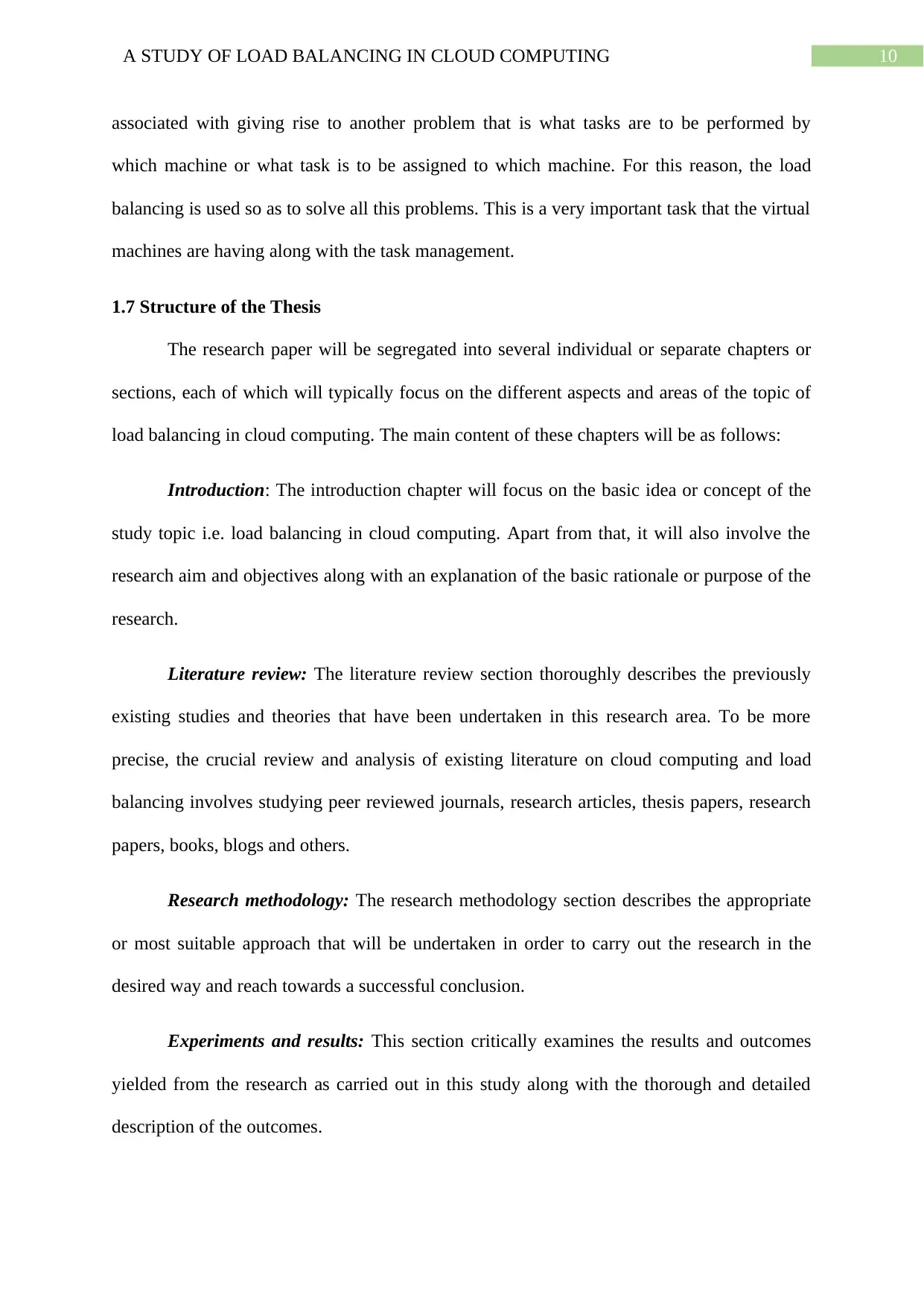
10A STUDY OF LOAD BALANCING IN CLOUD COMPUTING
associated with giving rise to another problem that is what tasks are to be performed by
which machine or what task is to be assigned to which machine. For this reason, the load
balancing is used so as to solve all this problems. This is a very important task that the virtual
machines are having along with the task management.
1.7 Structure of the Thesis
The research paper will be segregated into several individual or separate chapters or
sections, each of which will typically focus on the different aspects and areas of the topic of
load balancing in cloud computing. The main content of these chapters will be as follows:
Introduction: The introduction chapter will focus on the basic idea or concept of the
study topic i.e. load balancing in cloud computing. Apart from that, it will also involve the
research aim and objectives along with an explanation of the basic rationale or purpose of the
research.
Literature review: The literature review section thoroughly describes the previously
existing studies and theories that have been undertaken in this research area. To be more
precise, the crucial review and analysis of existing literature on cloud computing and load
balancing involves studying peer reviewed journals, research articles, thesis papers, research
papers, books, blogs and others.
Research methodology: The research methodology section describes the appropriate
or most suitable approach that will be undertaken in order to carry out the research in the
desired way and reach towards a successful conclusion.
Experiments and results: This section critically examines the results and outcomes
yielded from the research as carried out in this study along with the thorough and detailed
description of the outcomes.
associated with giving rise to another problem that is what tasks are to be performed by
which machine or what task is to be assigned to which machine. For this reason, the load
balancing is used so as to solve all this problems. This is a very important task that the virtual
machines are having along with the task management.
1.7 Structure of the Thesis
The research paper will be segregated into several individual or separate chapters or
sections, each of which will typically focus on the different aspects and areas of the topic of
load balancing in cloud computing. The main content of these chapters will be as follows:
Introduction: The introduction chapter will focus on the basic idea or concept of the
study topic i.e. load balancing in cloud computing. Apart from that, it will also involve the
research aim and objectives along with an explanation of the basic rationale or purpose of the
research.
Literature review: The literature review section thoroughly describes the previously
existing studies and theories that have been undertaken in this research area. To be more
precise, the crucial review and analysis of existing literature on cloud computing and load
balancing involves studying peer reviewed journals, research articles, thesis papers, research
papers, books, blogs and others.
Research methodology: The research methodology section describes the appropriate
or most suitable approach that will be undertaken in order to carry out the research in the
desired way and reach towards a successful conclusion.
Experiments and results: This section critically examines the results and outcomes
yielded from the research as carried out in this study along with the thorough and detailed
description of the outcomes.
Paraphrase This Document
Need a fresh take? Get an instant paraphrase of this document with our AI Paraphraser

11A STUDY OF LOAD BALANCING IN CLOUD COMPUTING
Conclusion: The conclusion chapter briefly gives an overview of the overall research
as undertaken in this study and portrays the relevant and useful outcomes as discussed in the
previous chapters.
Conclusion: The conclusion chapter briefly gives an overview of the overall research
as undertaken in this study and portrays the relevant and useful outcomes as discussed in the
previous chapters.
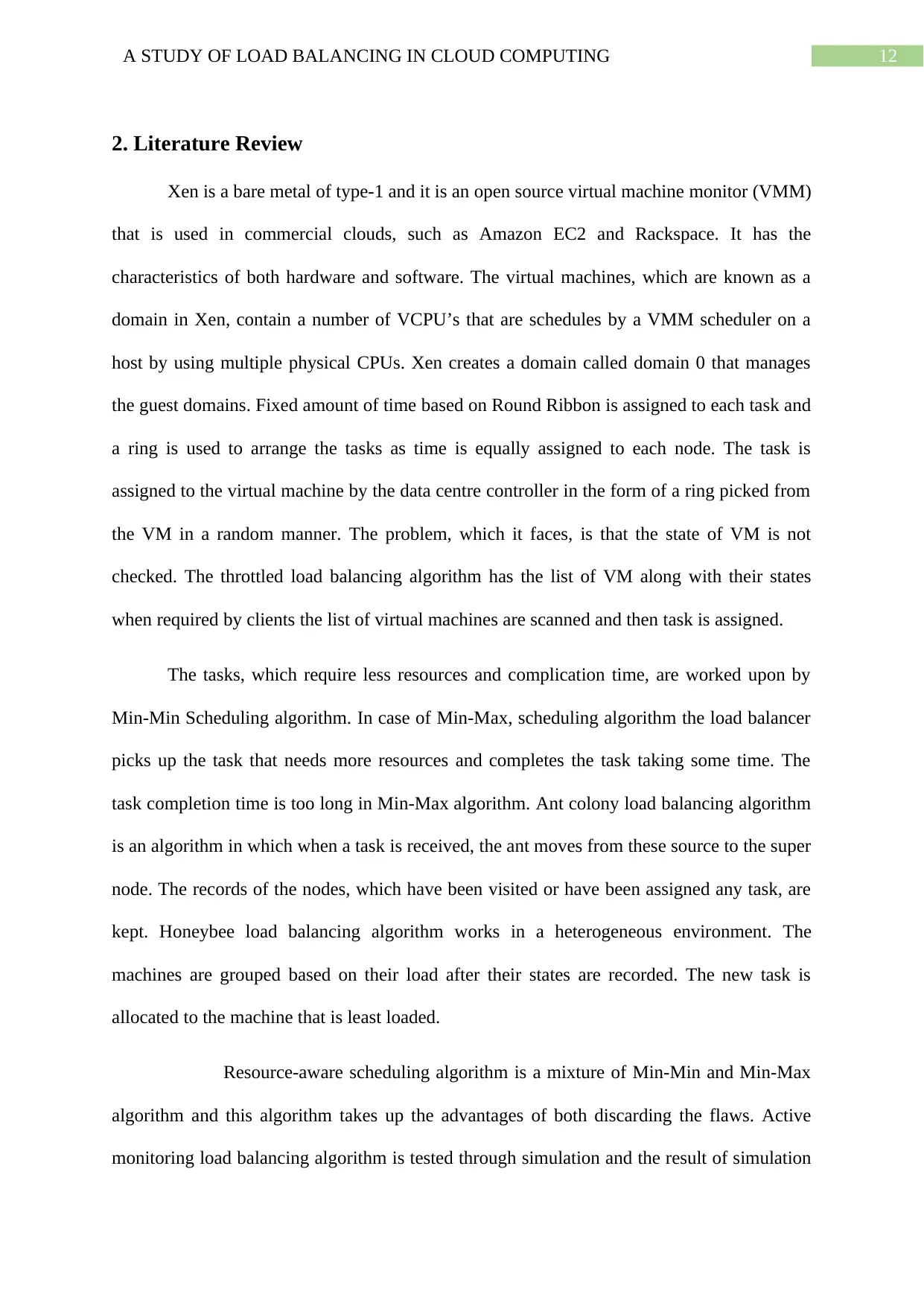
12A STUDY OF LOAD BALANCING IN CLOUD COMPUTING
2. Literature Review
Xen is a bare metal of type-1 and it is an open source virtual machine monitor (VMM)
that is used in commercial clouds, such as Amazon EC2 and Rackspace. It has the
characteristics of both hardware and software. The virtual machines, which are known as a
domain in Xen, contain a number of VCPU’s that are schedules by a VMM scheduler on a
host by using multiple physical CPUs. Xen creates a domain called domain 0 that manages
the guest domains. Fixed amount of time based on Round Ribbon is assigned to each task and
a ring is used to arrange the tasks as time is equally assigned to each node. The task is
assigned to the virtual machine by the data centre controller in the form of a ring picked from
the VM in a random manner. The problem, which it faces, is that the state of VM is not
checked. The throttled load balancing algorithm has the list of VM along with their states
when required by clients the list of virtual machines are scanned and then task is assigned.
The tasks, which require less resources and complication time, are worked upon by
Min-Min Scheduling algorithm. In case of Min-Max, scheduling algorithm the load balancer
picks up the task that needs more resources and completes the task taking some time. The
task completion time is too long in Min-Max algorithm. Ant colony load balancing algorithm
is an algorithm in which when a task is received, the ant moves from these source to the super
node. The records of the nodes, which have been visited or have been assigned any task, are
kept. Honeybee load balancing algorithm works in a heterogeneous environment. The
machines are grouped based on their load after their states are recorded. The new task is
allocated to the machine that is least loaded.
Resource-aware scheduling algorithm is a mixture of Min-Min and Min-Max
algorithm and this algorithm takes up the advantages of both discarding the flaws. Active
monitoring load balancing algorithm is tested through simulation and the result of simulation
2. Literature Review
Xen is a bare metal of type-1 and it is an open source virtual machine monitor (VMM)
that is used in commercial clouds, such as Amazon EC2 and Rackspace. It has the
characteristics of both hardware and software. The virtual machines, which are known as a
domain in Xen, contain a number of VCPU’s that are schedules by a VMM scheduler on a
host by using multiple physical CPUs. Xen creates a domain called domain 0 that manages
the guest domains. Fixed amount of time based on Round Ribbon is assigned to each task and
a ring is used to arrange the tasks as time is equally assigned to each node. The task is
assigned to the virtual machine by the data centre controller in the form of a ring picked from
the VM in a random manner. The problem, which it faces, is that the state of VM is not
checked. The throttled load balancing algorithm has the list of VM along with their states
when required by clients the list of virtual machines are scanned and then task is assigned.
The tasks, which require less resources and complication time, are worked upon by
Min-Min Scheduling algorithm. In case of Min-Max, scheduling algorithm the load balancer
picks up the task that needs more resources and completes the task taking some time. The
task completion time is too long in Min-Max algorithm. Ant colony load balancing algorithm
is an algorithm in which when a task is received, the ant moves from these source to the super
node. The records of the nodes, which have been visited or have been assigned any task, are
kept. Honeybee load balancing algorithm works in a heterogeneous environment. The
machines are grouped based on their load after their states are recorded. The new task is
allocated to the machine that is least loaded.
Resource-aware scheduling algorithm is a mixture of Min-Min and Min-Max
algorithm and this algorithm takes up the advantages of both discarding the flaws. Active
monitoring load balancing algorithm is tested through simulation and the result of simulation
⊘ This is a preview!⊘
Do you want full access?
Subscribe today to unlock all pages.

Trusted by 1+ million students worldwide
1 out of 45
Related Documents
Your All-in-One AI-Powered Toolkit for Academic Success.
+13062052269
info@desklib.com
Available 24*7 on WhatsApp / Email
![[object Object]](/_next/static/media/star-bottom.7253800d.svg)
Unlock your academic potential
Copyright © 2020–2025 A2Z Services. All Rights Reserved. Developed and managed by ZUCOL.





